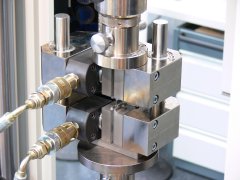Zwick is offering a patented new fixture which they believe will quickly become a standard for the testing of fiber-reinforced plastics. The Hydraulic Composite Compression Fixture (HCCF) fixture, with its hydraulically operated specimen grips, offers several technical and cost saving advantages compared to existing and often troublesome mechanical fixtures such as Celanese or IITRI devices.

The open C-frame construction facilitates the simple and fast loading of specimens and allows for easy attachment of extensometers. The difficulty in specimen alignment and mechanical set-up often found with traditional fixtures has been eliminated mainly due to a friction free and precise guidance system.
Zwick claims that the HCCF reduces variance in test results, and speeds up test throughput saving time and money.
Hydraulic operation guaranties reliable and reproducible clamping of the specimens as the clamping force is applied uniformly and securely across the specimen.
The compression testing fixture can also be used at high or low temperatures ranging from -60 to +95° C, and the ability to utilise extensometers saves even more and money by avoiding the need to bond strain gauges to the specimen.
Zwick's Hydraulic Composite Compression Fixture (HCCF) is used specifically for the testing of carbon-fibre-reinforced plastics (CFRP) and glass-fibre-reinforced plastics (GFRP) with unidirectional fibre-reinforcement. It is suitable for testing standards such as prEN 2850, DIN EN ISO 14126, DIN 65380, and QVA-Z10-46-38.